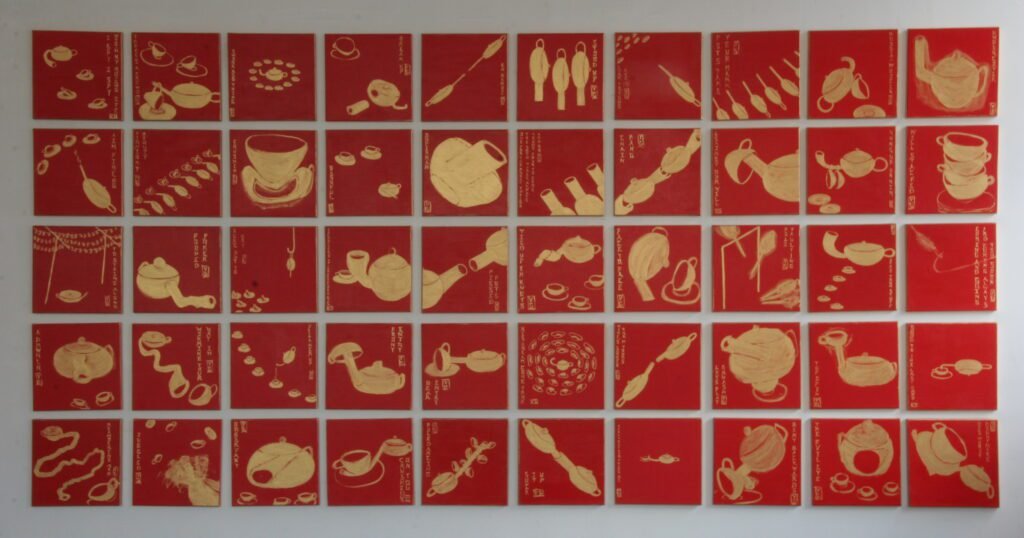Artist Vicki Genberg on Understanding the Intricacies of Power Dynamics in Life and Art

Vicki Genberg was born in Cincinnati, Ohio, but has lived many years in Switzerland and now divides her time between Switzerland and Malaysia. In this interview, she discusses her fascination with body language and emotional expression, highlighting how these elements inform her artwork. Vicki also reflects on her personal experiences and observations of relationships, both intimate and societal, as she seeks to uncover the intricate patterns of power that govern human interactions. While living in Hong Kong, she was introduced to Chinese ink painting, which she felt had a significant impact on her work due to its expressive possibilities.

Vicki Genberg was born in Cincinnati, Ohio, but has lived many years in Switzerland, and now divides her time between Switzerland and Malaysia. After BFA from the School of Visual Arts in New York, she moved to Hong Kong where she completed her MFA from the Royal Institute of Technology. The medium she chooses varies according to what is most appropriate for a particular project. What is perhaps most characteristic is her free-flowing, expressive mark-making. While living in Hong Kong she was introduced to Chinese ink painting. The expressive possibilities inherent to this medium suited her process and had a big impact on her work. The combination of a non-traditional ink style with techniques such as oil pastel and collage brings about a fusion of East and West sensibilities.
1. Can you tell us a little about yourself and your background?
I once did a sort of “test” that predicts, based on your style of problem-solving, what professions would be most appropriate for you. My prediction indicated either a scientist or an artist. Interesting that scientists and artists have similar approaches to problem-solving, because I was first a researcher in education, before becoming an artist. Therefore I started relatively late, beginning by joining local classes (in Switzerland, outside Geneva) in drawing, painting, and sculpture. I decided to take it more seriously and moved to New York to get a BFA at the School of Visual Arts, then continued to do an MFA when we moved to Hong Kong. People often ask if I am influenced by living in different places. I would say the nature in Switzerland has influenced quite a lot. The mountains, fir trees, and birch trees are very present in the part of my work that portrays nature. I have been surrounded by that for so long. Curiously the tropical landscape in Hong Kong, and now Malaysia, have not inspired me to the same extent. Living in Hong Kong introduced me to Chinese painting. I did not like the traditional way of teaching years of copying masters, but was fortunate to find a teacher who was much freer in her technique. It suited my need for expressive brush strokes and untraditional ink painting techniques.
Facial expressions are an indication of people’s emotional state. It is fascinating how a slight change of angle in the eyes or the mouth then conveys a quite different emotion.
Vicki Genberg

2. What inspired you to become an artist?
I think I sort of fell into being an artist by circumstances. I was always artistic but expressed it through decorating the house and decorating for holidays, and things like that. I was working on my PhD dissertation and was very isolated so I started drawing and painting classes for fun and to break out of the lonely situation I was in. It was so satisfying that I abandoned my research career to pursue art. I am happy when I am working. I lose myself in it and feel at peace. The inspiration to be an artist came from just doing it.

3. What is your creative process like from start to finish?
My process. I would say that most of the time I don’t start with a well-defined idea, but rather with an emotional reaction to something that is nagging me. Right now I am thinking about the invisibility of women, particularly older women. I might make a list of how I think I could communicate my emotional reaction to that situation. I could draw a figure or even just a head that portrays older women and cover over it or put it between layers of paint or fabric for example to show how little she is visible. I will start with one of these ideas and then it just takes off from there. If I feel like it’s not effective I will try other mediums or other images. Often there is an accident that gives an interesting effect that I will then replicate. At one point I was drawing piles of fruit from photos of fruit stalls in Hong Kong with conti crayon. By accident, I splashed water on a drawing and the crayon ran. I loved it. The effect turned a pile of fruit into a statement about the dark side of life. I used water to create the same effect on the other drawings and had a whole series that sold well. Happy accident!

4. Where do you find inspiration for your artwork?
I think I am often inspired by an image that catches my eye. This can be from the natural world, personal photos in mass media, or another artist’s work. A tree with a particular shape, or even a branch that is dramatic will catch my attention. How the play of light and shadows on mountains gives them shape and emotional resonance fascinates me. Recently on a boat in Greece on a cloudy day, I admired the colors of the hills that consisted of beige earth, olive green and rust-colored vegetation, which were then reflected in the gray water. It was a beautiful harmony of colors. I collect images from magazines and newspapers depicting individuals whose body position and/or facial expressions strike me as interesting. Often it’s because they are unusually expressive or dramatic. These serve to communicate the emotional content of my work.
Much of my work is intended to communicate relational dynamics through bodies ‘ positions in space, their relative sizes, angles of torsos, legs, arms and heads, and the distance between them.
Vicki Genberg

5. Can you tell us about a particular piece of art that holds special meaning for you?
I am proud of my “Teapot Series”. There are over fifty canvases 12″x12″ painted red with teapots and teacups in gold, colors that in Chinese culture mean prosperity and good luck. It is actually about power dynamics between males and females and between males. The teapots represent males, and the cups, on the receiving end, represent females. I use humorous, often stereotyped sayings to express the dynamics. For example, a teapot with a very long meandering spout observes a cup. “I spy, I spy, with my meandering eye.” A large pot with a large spout is “Superman”. Two pots comparing spouts is called “Mine is longer than yours.” A recent canvas is a large pot with a very small spout. This is “Trump’s Trumpet.” These express typical situations between the sexes in a very humorous way and make for an eye-catching when fifty are hung together.

Vicki Genberg’s art shows how powerful creativity can be in exploring and expressing our feelings about relationships. By combining traditional techniques with her unique style, she creates pieces that resonate with many people. As she dives deeper into themes like visibility and power in her work, Vicki aims to spark conversations and insights. To learn more about Vicki, visit the links below.
